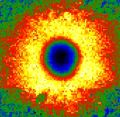Speaker
Description
With the rise of nanostructured photovoltaics came the need for characterisation of photovoltaic properties on the nanoscale. The best candidate to fulfil this need is, in many cases, scanning probe microscopy (SPM), and for electrical characterisation, current-detecting AFM (C-AFM) is the natural candidate of choice.
During any current-detecting AFM measurement, we detect current that flows through a circuit that consists of the microscope, the probe tip, the cantilever and chip, the sample, and all the interfaces between them. Aside from the spreading resistance of the sample ($R_{sample}$), we can see that the measurement is dependent on the resistance of the tip ($R_{tip}$) that changes with the tip material and shape. The most problematic part of the measurement circuit is, however, the electrical contact between the tip and the sample, characterised by $R_{cont}$.
While there is a relatively large number of studies of the environmental effects on the cur-rent detection (with unsurprising conclusion that the optimal results can be achieved in a protective atmosphere such as nitrogen one or, even better, in vacuum), other aspects of the measurement have been neglected. The influence of the sample geometry, tip-sample electrical contact and its evolution with changing normal contact force between the probe and the sample is yet to be properly analysed. Furthermore, experiments performed by several groups indicate a strong dependence of the detected current and especially the $R_{cont}$ on the tip-sample contact force.
In my talk, I would like to share findings and thoughts regarding the tip-sample contact resistance and its changes caused by sample topography as well as practical demonstration on how to out-smart these and other inherently present shortcomings of current-detecting AFM in regard to the characterisation of solar cell electronic properties. Since the tip-sample resistance diminishes with increasing contact force, in some instances, extremely high contact forces that lead to partial material removal during the measurement can, surprisingly, lead to the best result. To prove this point, the application of two advanced techniques, Scalpel C-AFM and C-AFM Tomography [1], [2] will be demonstrated on the silicon solar cell samples.
[1] U. Celano et al., ‘Conductive-AFM tomography for 3D filament observation in resistive switching devices’, in 2013 IEEE International Electron Devices Meeting, Dec. 2013, p. 21.6.1-21.6.4. doi: 10.1109/IEDM.2013.6724679.
[2] M. Hývl et al., ‘Nanoscale Study of the Hole-Selective Passivating Contacts with High Thermal Budget Using C-AFM Tomography’, ACS Appl. Mater. Interfaces, vol. 13, no. 8, pp. 9994–10000, Mar. 2021, doi: 10.1021/acsami.0c21282.

